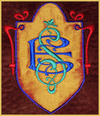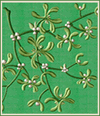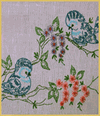How & Why to Embroider on Wood
You've read the title just right. There really is a type of wood that can be used for machine embroidery - it is called Balsa. These intriguing trees grow naturally in the humid rain forests of Central and South America. Balsa wood is extremely lightweight, strong and is available in thin sheets that can be compared to heavyweight paper in terms of thickness. For this reason Balsa sheets are often used for various hobbies, including machine embroidery.
Naturally, Balsa is NOT a perfect material for embroidery, because it's still wood. It's not elastic enough, and if mistreated, can break. Yet, there is a reason why you may want to embroider on it. And this can be done successfully.
Most craft shops are full of unfinished wooden accessories (which are usually used for tole painting) - boxes in all shapes, newspaper racks, trays, jewelry boxes, recipes and tissue boxes, drawers, trash cans etc. All made of unfinished natural wood. You've probably seen such items hundreds of times. Usually crafters paint on them and/or cover with some kind of varnish, to create beautiful, finished look.
As alternative to painting, you may put embroidery on such items. And here comes the Balsa, because it's exactly the same color and feel like the raw wood stuff mentioned above. So a sheet of Balsa wood with embroidery on it can be easily glued to a wooden accessory, and look as if the embroidery was put directly on that piece of furniture. Look at these cute cross-stitched kitchen trays, for example:
Required Supplies & Tools
1. Polyester thread in suitable colors
2. 2 mini trays from unfinished light wood (available at local craft shops)
3. Embroidery designs in cross-stitch technique
4. Cutaway backing
5. Thin water-soluble topping
6. Temporary adhesive spray
7. White craft glue (available in Wal-Mart and craft shops)
8. Balsa Wood Sheets - 8" wide, at 1/16 thickness (available at http://www.specializedbalsa.com/balsa_sheets.php)
9. Rotary cutter (available in craft shops)
Warnings & Tips
1. Be sure to purchase the Balsa in 1/16 thickness. Thinner Balsa falls apart, and is bad for embroidery. Too thick sheets may be bad as well. Also, pay attention that the sheets are homogenous and of an appropriate size - to fit your project AND the inside part of your largest hoop.
2. Select loose embroidery designs for embroidery on wood. Machine cross-stitch designs in 14 count are perfect. 16 count is also good. On our photos, the pears are in 16 count and the peaches - in 14 count. Avoid designs with straight edges / frames, especially when these edges are in the same direction of wood growth, because the embroidered design can be "cut out" of the wood by it's own stitches.
Step-By-Step Instruction
Step 1: Measure the inside surface of your trays. Draw a rectangle on Balsa, exactly the size of your measurements. Cut it out with rotary cutter and ruler. Find the middle on each side of your Balsa rectangle, and mark it. Hoop a layer of strong cutaway backing, and mark the center of sewing field (like on our photo):
Step 2: Apply a generous amount of temporary adhesive spray on all hooped cutaway surface, and then stick the Balsa over it. Make sure it's accurately centered. Let the spray dry for 10 - 15 minutes. Place 2 layers of THIN water-soluble topping over the Balsa. You may secure it in place by applying spray adhesive on a few small spots.
Step 3: Embroider perfectly centered, LOOSE design, at the lowest speed of your embroidery machine. We've used designs in cross stitch technique, 14 and 16 counts. Their density is appropriate for Balsa. Denser designs may create problems. Also, be sure to AVOID designs with straight edges and/or frames, especially when those edges are in the same direction of wood growth. Otherwise the embroidery may be just "cut out" of Balsa by it's own stitches. When embroidery is finished, take the hoop out, and tear away the topping very carefully, one layer after another (NOT together). If you notice any difficulty in tearing - use small scissors. Just be sure not to damage the wood, and stitches.
Step 4: Unhoop cutaway backing. Place the backing & embroidered Balsa on working surface. Cut away the edges of cutaway, exactly according to the edges of Balsa sheet, using rotary cutter. Then, carefully glue the remaining edges of cutaway to Balsa, using white plastic glue. Put the embroidered Balsa sheet under press to dry. Let it dry for a few hours.
Step 5: Glue the embroidered Balsa to the inside surface of your tray, using white craft glue. And again, put the project under press to dry. It should dry for a few hours. When ready, you may cover the tray with translucent vanish.

Naturally, Balsa is NOT a perfect material for embroidery, because it's still wood. It's not elastic enough, and if mistreated, can break. Yet, there is a reason why you may want to embroider on it. And this can be done successfully.
Most craft shops are full of unfinished wooden accessories (which are usually used for tole painting) - boxes in all shapes, newspaper racks, trays, jewelry boxes, recipes and tissue boxes, drawers, trash cans etc. All made of unfinished natural wood. You've probably seen such items hundreds of times. Usually crafters paint on them and/or cover with some kind of varnish, to create beautiful, finished look.
As alternative to painting, you may put embroidery on such items. And here comes the Balsa, because it's exactly the same color and feel like the raw wood stuff mentioned above. So a sheet of Balsa wood with embroidery on it can be easily glued to a wooden accessory, and look as if the embroidery was put directly on that piece of furniture. Look at these cute cross-stitched kitchen trays, for example:
 |
Required Supplies & Tools
1. Polyester thread in suitable colors
2. 2 mini trays from unfinished light wood (available at local craft shops)
3. Embroidery designs in cross-stitch technique
4. Cutaway backing
5. Thin water-soluble topping
6. Temporary adhesive spray
7. White craft glue (available in Wal-Mart and craft shops)
8. Balsa Wood Sheets - 8" wide, at 1/16 thickness (available at http://www.specializedbalsa.com/balsa_sheets.php)
9. Rotary cutter (available in craft shops)
Warnings & Tips
1. Be sure to purchase the Balsa in 1/16 thickness. Thinner Balsa falls apart, and is bad for embroidery. Too thick sheets may be bad as well. Also, pay attention that the sheets are homogenous and of an appropriate size - to fit your project AND the inside part of your largest hoop.
2. Select loose embroidery designs for embroidery on wood. Machine cross-stitch designs in 14 count are perfect. 16 count is also good. On our photos, the pears are in 16 count and the peaches - in 14 count. Avoid designs with straight edges / frames, especially when these edges are in the same direction of wood growth, because the embroidered design can be "cut out" of the wood by it's own stitches.
 |
Step-By-Step Instruction
Step 1: Measure the inside surface of your trays. Draw a rectangle on Balsa, exactly the size of your measurements. Cut it out with rotary cutter and ruler. Find the middle on each side of your Balsa rectangle, and mark it. Hoop a layer of strong cutaway backing, and mark the center of sewing field (like on our photo):
 |
Step 2: Apply a generous amount of temporary adhesive spray on all hooped cutaway surface, and then stick the Balsa over it. Make sure it's accurately centered. Let the spray dry for 10 - 15 minutes. Place 2 layers of THIN water-soluble topping over the Balsa. You may secure it in place by applying spray adhesive on a few small spots.
 |
Step 3: Embroider perfectly centered, LOOSE design, at the lowest speed of your embroidery machine. We've used designs in cross stitch technique, 14 and 16 counts. Their density is appropriate for Balsa. Denser designs may create problems. Also, be sure to AVOID designs with straight edges and/or frames, especially when those edges are in the same direction of wood growth. Otherwise the embroidery may be just "cut out" of Balsa by it's own stitches. When embroidery is finished, take the hoop out, and tear away the topping very carefully, one layer after another (NOT together). If you notice any difficulty in tearing - use small scissors. Just be sure not to damage the wood, and stitches.
 |
Step 4: Unhoop cutaway backing. Place the backing & embroidered Balsa on working surface. Cut away the edges of cutaway, exactly according to the edges of Balsa sheet, using rotary cutter. Then, carefully glue the remaining edges of cutaway to Balsa, using white plastic glue. Put the embroidered Balsa sheet under press to dry. Let it dry for a few hours.
 |
Step 5: Glue the embroidered Balsa to the inside surface of your tray, using white craft glue. And again, put the project under press to dry. It should dry for a few hours. When ready, you may cover the tray with translucent vanish.
 |




